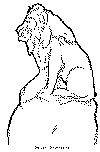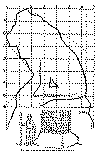By Dan Beard
Since snow is easily carved and modeled, there is no good reason why statues of some merit should not replace the grotesque effigies which most men have built during the day, of their boyhood. The better the work the more enjoyable the occupation, the more fun there is in the doing of it.
In place of building a figure by sticking lumps of snow on to other lumps, balls for eyes and ears and another for a nose, why not make a solid block of snow and carve the face from it?
Suppose A (Fig. 445) to be a snow block, B then shows the first effects of carving, C the next step, and in D we already have the semblance of a head and bust; E begins to show some likeness to a well-known American, and F and G, Fig. 446 may be passed upon an unsuspecting public as a portrait of the Father of Our Country.
In making this bust, remember and make the epaulets limp, mere bands of braid and fringe on edge, for that is the kind were at that date--the upholstered epaulets seen upon the statues in New York City, and elsewhere were not invented until after Washington's death, and like the sword of 1861, which the bronze Washington usually carries, are simply marks of the sculptor's ignorance or carelessness.
If you make a snowman,
Make Him Right!
Of course there are many to whom these diagrams (A to G) will be of little assistance, but even untrained eyes and unskilled hands can do a thing mechanically, for that requires only care and patience. So, though you may not be able to make anything more resembling Washington than the background figure with a hat in Fig. 446, you may at least make a statue of the beast Washington drove from his country (Fig. 447).
Build a solid snow block 7 squares long by 8 squares long by 8 squares high and 4 squares broad. These squares may be of any size you find convenient, 6 inches or 1 foot, or greater or less. See the small diagram at bottom of Fig. 448. This block of snow should rest upon a rough base to elevate it above the ground. With a board and rule or string and wooden pegs divide the snow block as shown by Figs. 448 and 449. Take a print out of this diagram in the left hand, a pointed stick in the right hand and sketch the outline of the lion.
Placing the point of the stick a trifle to the left of the middle of the square (I, 2) and tracing a line through I to a point a quarter of the distance from I to O and half way between the line A and I, thence perpendicularly down, crossing the line A and swinging off diagonally to a point in the line O a quarter distant between B and C, thence to a point on C a quarter distant from line I, thence down diagonally to a point just to the right of I and above D, and so on as shown in the diagram.
When this is done the artist will find that he has traced out a duplicate of the diagram (Fig. 448). If he will now trace the heavy outlines of the front and rear view shown by Fig. 449, he will have something to guide him in cutting away the snow. The dotted lines show the first cuts to make on the profile view; but it will possibly be wise for him to leave the front until the last so that the outlines of front until the last so that the outlines of front view will be there to guide him. These he may cut away on one side back to the front legs, before he finishes the profile.
A few experiments will teach him how the thing is done, and if he makes a mistake it may be rectified by plastering the snow back firmly in place and trying it again.
There is a chunk of snow left between the legs to give stability to the statue, and the legs are carved in high relief, but the snow is left under the body for support. The texture of hair on the mane and head may be reproduced by using a coarse comb.
The squares on the lion may have sides of 6 inches, 12 inches, or any dimensions the would-be sculptor may choose so long as all sides are equal.
If these directions are followed, with a copy of this diagram in your hand for reference, the result will no doubt be a surprise to your friends and a proportional subject of pride to yourself.
After acquiring some skill, the beginner can take any picture man or woman , divide it into squares, and reproduce a creditable copy in snow.
A grotesque portrait can be modeled by marking the divisions, as described, on the picture to be copied, but making them of unequal sides on the snow block; for instance, if the sides are 16 inches broad and 10 inches high you will elongate your subject to a ridiculous degree, and if the copy is made with divisions 6 inches high and 10 inches wide, you will broaden the figure to a laughable extent. In any case you will pass a few hours in a healthy outdoor pursuit, and come indoors with red cheeks and an appetite which demands immediate attention.



